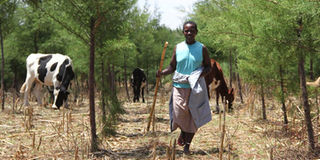Breaking News: KDF chopper crash kills five
Farmers near forests reap big gains from conservation plan

A woman grazes cattle in Kapsaret Forest Station, Uasin Gishu, where maize had initially been planted. Locals are given portions of the forest where there are no trees to cultivate and plant maize, as they take care of Cyprus trees. PHOTO | JARED NYATAYA | NATION MEDIA GROUP
What you need to know:
- Project has improved livelihoods, boosted catchment areas and reduced soil erosion.
- The forest department has also set up a tree nursery with more than one million tree seedlings which are set to be planted during the onset of the rainy season in a month’s time.
- Schools such as Timboroa Primary are the biggest beneficiaries of the project as they are assured of a constant supply of water courtesy of the initiative.
While many Kenyans are grappling with an acute food insecurity occasioned by the prolonged dry spell, a move by Uasin Gishu County residents to engage in shamba system is paying off with millions of shilling generated from the initiative.
Residents bordering various forests in the region have embraced the Plantation Improvement Livelihood Scheme (PILS) where they engage in cultivation of food crops as they help conserve forests through various Community Forest Associations (CFAs).
“The main concept of the project is that residents adjacent to forests are allowed to do farming as they tend to trees for a period of three years,” said Uasin Gishu County KFS conservator Paul Karanja.
Under the initiative, KFS charges residents Sh500 per acre every year where they tend to trees as they plant their food crops.
According to Mr Karanja, the arrangement which started in 2010, wananchi also prune the trees and get some money from KFS.
He said apart from boosting the community’s livelihoods and helping in forest conservation, the project has also helped the forest department rein in wild fires.
“It has also boosted water catchment protection, reduced soil erosion and climate change mitigation,” said Mr Karanja during a tour of the area last week.
The forest department has also set up a tree nursery with more than one million tree seedlings which are set to be planted during the onset of the rainy season in a month’s time.
“PILS is successful because of community support. In the arrangement, farmers are allowed to cultivate for three years. By then, tree cover will have closed the canopy and crops will not do well due to the shade,” Mr Karanja told Smart Company.
“The community has come to appreciate that we can both co-exist. The project has empowered the youth by enabling them to buy plots, livestock and even vehicles.”
TRANSFORMING LIVELIHOODS
The biggest beneficiaries of the project are members of the Kapseret and Timboroa associations, who are now able to meet their daily needs including taking their children to school.
Timboroa CFA chairman Peter Kimani said their group with 1,500 members harvests 3,500 bags of potatoes twice a year at Sh1,500 a bag earning them more than Sh5.2 million.
“The project has not only improved the livelihoods of our people but has also boosted food security in the region. We are assured of plenty of milk throughout the year as we’ve set aside part of the plantations for livestock grazing,” said Kapseret CFA chairman Shadrack Koech.
“The public is acting as forest scouts and reports to KFS any illegal activities. We also get herbal medicine which are not available in other besides getting fresh air,” said Mr Koech. Apart from potatoes, residents also cultivate maize and vegetables.
He said the project has minimised conflicts, which were the norm in the past, between the Kenya Forest Service (KFS) rangers and wananchi, .
A spot check by at Timboroa Shopping centre revealed that indeed the project was transforming the region with heavy trucks ferrying farm produce including potatoes and vegetables. Customers come from as far as Mombasa.
Schools such as Timboroa Primary are the biggest beneficiaries of the project as they are assured of a constant supply of water courtesy of the initiative.
The school head Michael Kiberia said the pupils used to walk for long distances in the past in search of water.
“This was risky to them as they passed through the bush to reach the nearest water source. Now we are enjoying piped water courtesy of this worthy initiative,” said Mr Kiberia.





